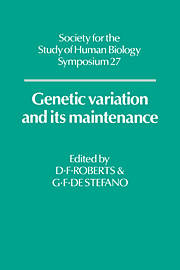Book contents
- Frontmatter
- Contents
- Preface
- Part I Genetic Diversity - Its Dimensions
- Part II Genetic Diversity - Its Origin and Maintenance
- Human genetic diversity in south-east Asia and the western Pacific
- Malaria-protective alleles in southern Africa: relict alleles of no health significance
- The genetic origin of the variability of the phenotypic expression of the Hb S gene
- Origin and maintenance of genetic variation in Black Carib populations of St. Vincent and Central America
- Historical and demographic factors and the genetic structure of an Afro-American Community of Nicaragua
- Migration and genetic polymorphisms in some Congo peoples
- Population structure studies and genetic variability in humans
- Inbreeding and the incidence of recessive disorders in the populations of Karnataka, South India
- Genetic diversity at the albumin locus
- GENETIC DIVERSITY - APPLICATIONS AND PROBLEMS OF COMPLEX CHARACTERS
- Index
Human genetic diversity in south-east Asia and the western Pacific
Published online by Cambridge University Press: 05 March 2012
- Frontmatter
- Contents
- Preface
- Part I Genetic Diversity - Its Dimensions
- Part II Genetic Diversity - Its Origin and Maintenance
- Human genetic diversity in south-east Asia and the western Pacific
- Malaria-protective alleles in southern Africa: relict alleles of no health significance
- The genetic origin of the variability of the phenotypic expression of the Hb S gene
- Origin and maintenance of genetic variation in Black Carib populations of St. Vincent and Central America
- Historical and demographic factors and the genetic structure of an Afro-American Community of Nicaragua
- Migration and genetic polymorphisms in some Congo peoples
- Population structure studies and genetic variability in humans
- Inbreeding and the incidence of recessive disorders in the populations of Karnataka, South India
- Genetic diversity at the albumin locus
- GENETIC DIVERSITY - APPLICATIONS AND PROBLEMS OF COMPLEX CHARACTERS
- Index
Summary
INTRODUCTION
The scenarios discussed in this paper are based on my own work during the last 25 years, supplemented with studies of other investigators, and made possible through collaboration with many colleagues. To these persons, too numerous to mention here, I am deeply indebted.
Our investigations have been concerned with people of many different ethnic origins, covering a wide geographical area, from India and Sri Lanka in the west, through Malaysia, Thailand, Indonesia, and New Guinea, to the central Pacific in the east. Population structures of the peoples studied range also from small tribal enclaves within larger communities, or isolated island populations through to populations with well defined social castes of wide dispersal. The genetic variability is equally varied, and the genetic relationships between these populations is complex, being a compound of diversity of origins, migration and intermixture, and adaptation to particular environments. Certainly we do not yet fully understand this complexity, but we have unravelled some part of it, enough now to see what needs to be studied further.
These studies have covered human populations in the tropics. This does not mean that all live in a uniform environment. Their habitats vary from tropical rain-forest to desert, from sea level to several thousand metres elevation. Their economic base likewise covers hunter-gatherers, slash and burn cultivators, to settled agriculturalists and urban dwellers. Sometimes ecological differences are broadly based, as in India and South-East Asia, sometimes they occur within a small geographic area.
India and South-East Asia
For India and South-East Asia there are broad ecological zones.
- Type
- Chapter
- Information
- Genetic Variation and its Maintenance , pp. 113 - 134Publisher: Cambridge University PressPrint publication year: 1986

